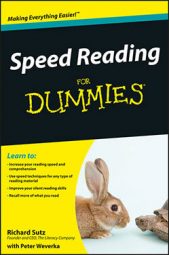A major component of speed reading is eye fixation, a point where your eyes come to rest as you read. Readers who make fewer eye fixations read faster because they take in more words with each fixation. The number of words you can process in an eye fixation depends on your vision span, your vocabulary, and your familiarity with what you’re reading.
Eye fixations and vision span
The wider your vision span is, the more words you can process in an eye fixation and the faster you can read. Acquiring the ability to see many words at a time is essential for speed reading. To see why, consider this sentence:
The rain in Spain stays mainly in the plain.
A slow reader with a narrow vision span reads this sentence slowly in six to nine eye fixations, sometimes taking in only a single word per fixation. A fast reader with a wider vision span can read the sentence in two or three eye fixations. This reader has a stronger comprehension because she reads the sentence phrase by phrase, and phrases convey more meaning than individual words.
Eye fixations and vocabulary
To see how eye fixations correlate to vocabulary, read these lines carefully and try to understand their meaning:
Sownynge in moral vertu was his speche,
And gladly wolde he lerne, and gladly teche.
Unless you understand Middle English or you’re familiar with the writings of Geoffrey Chaucer (these lines come from The Canterbury Tales), you had trouble with these lines because few of the words are in your vocabulary. You didn’t recognize the words, so you had to examine them one at a time and probably read the lines in 15 (or more) eye fixations, one for each word.
Reading this translation of Chaucer’s lines is considerably easier because all or most of the words are in your vocabulary. Notice how much faster you read the translation:
Filled with moral virtue was his speech,
And gladly would he learn, and gladly teach.
You read the translation faster because you needed fewer eye fixations to read it. Because the words were familiar, you didn’t have to dwell on them, and you could read more than one word at a time.
The larger your vocabulary is, the more words you recognize when you read. You can take in more words with an eye fixation when you recognize the words, which is why enlarging your vocabulary is essential to being a speed reader.
Eye fixations and topic familiarity
How familiar you are with a topic is another factor influencing how many words you can see in a single eye fixation. When you read about a topic in your area of expertise or field of interest, you read more confidently, and you’re able to read more quickly with fewer eye fixations because you’re at home with the author’s words and terminology.
Your background, your general knowledge, your education — these factors also determine how fast you can read. People with a breadth of knowledge read faster because more is familiar to them. By making reading more efficient and pleasurable, speed reading encourages you to read, which in turn widens your breadth of knowledge and makes you read even faster.

